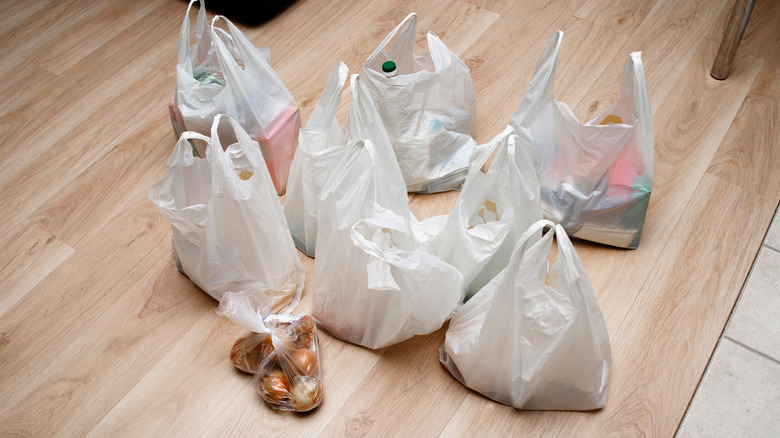Use TikTok's Hack To Fix Your Drafty Door With Leftover Plastic Bags
To help you stop losing warm air during winter, it's important to seal your door gaps. However, what if you find yourself in an emergency situation — like when a snowstorm knocks out your power, and you no longer have heat — and you have no way to plug those leaks? In moments like those, you can't simply run to the hardware store and get some new weather stripping for your door. In order to avoid walking around your house in winter coats and mittens until the power is restored, you can use plastic bags as a temporary insulator. According to TikTok, the same bags you get at grocery stores can double as door insulation with a little bit of finesse.
The reason your door is letting heat out is that the weather stripping that originally sealed it has worn down, allowing leaks in the spots where the stripping has deteriorated. The solution is to temporarily plug those gaps to keep your heat in, and you can DIY this by repurposing plastic bags into makeshift patches. Much like how some trusted utility companies recommend temporarily insulating unheated pipes with plastic bags, bubble wrap, or plastic sheets during a freeze since plastic is a good insulator, plastic bags can also help plug your doors. This can act as a temporary band-aid until the power kicks back on. Here's how.
How to use plastic bags as makeshift weather stripping
To pull off this hack and create your own emergency door draft blockers, all you need is a handful of leftover plastic bags and a butter knife. To start, feel around the door's frame. The places where you can feel cold air from the outside are where the stripping has worn off and where you'll want to add your plastic bags. Grab a couple of bags and use the butter knife to push them into the gap. You want to use more than one to insulate the hole properly. Do this around the entire door until you have plugged all of the leaks.
This temporary repair works for several reasons. First, plastic bags are thin enough to fit inside the small gaps in the door. For example, a towel or microfiber cloth would be too thick for most gaps. Second, plastic is a top-tier insulator. That's because its molecules are tightly arranged next to each other, making it difficult for the heat to flow through them. Molecules need to vibrate and collide with each other for the heat to move, and since they are so tightly packed together in plastic, that is hard to do. However, this hack should only be used as a short-term solution during emergencies because it's a rather temporary fix. Unlike permanent weather strips, the bags will fall out of the door each time they are opened, forcing you to reapply them.
